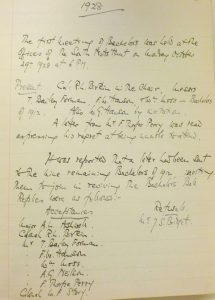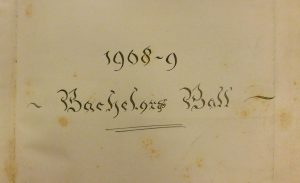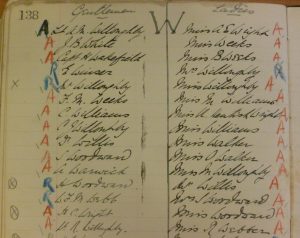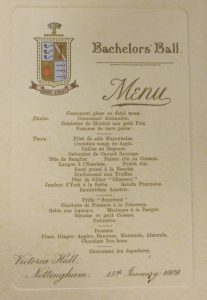May 25, 2017, by Kathryn Steenson
The Bachelors’ Balls
If a single man in possession of a good fortune was in want of a wife in late nineteenth century Nottingham, he rectified the situation by joining a committee and paying to host a ball to meet eligible young ladies.
This volume (MS 243: Minute book of the Bachelors’ Ball, Nottingham, 1908-1928) is the sole surviving record of the Nottingham Bachelors’ Ball. As the name suggests, a group of wealthy unmarried men, many of them young but a few comfortably into middle age, would organise a social event for several hundred carefully-chosen guests. The volume contains signed meeting minutes relating to the organisation of prestigious balls in Nottingham in 1909 and 1912, with mention of the earlier ball taking place in 1905 and an attempt to hold one in 1928.
The minutes capture the beginning of the end for Bachelors’ Balls. There must have been earlier records, and it’s a shame that none survive from the glittering heyday when they were attended by some of the highest of high society. According to his obituary printed in The Times in 1943, the 6th Duke of Portland was one of 60 bachelors who gave the 1880 Bachelors’ Ball, which led to the formation of the Bachelors’ Club. We have a list of subscribers who attended that important 1880 Ball, in archives of the Viscounts Galway of Serlby Hall, although we have no archives of the club itself. In 1943 there was no need to put Bachelors’ Balls in context for the readership, as those who had not attended one personally would have seen adverts for some of the more prestigious ones printed in The Times.
Nottingham’s Bachelors were invited by members of the committee, and were in turn permitted to invite eight people whom they felt were of the appropriate social and marital status – and, if male, were able to afford the £5 contribution to cover the costs (approx £300 today). Lists of acceptances and refusals are scattered throughout the minutes, and at the back is an index of gentlemen and ladies who had been invited. Most have been annotated with their marital status – B or M for Bachelor or Married, and D for members who had died in the intervening years.

Minutes planning the 1909 Ball, with annotations showing which men were still bachelors, had married or died since the 1905 Ball.
It must have been a glorious scene of upper-class Edwardian largesse. Almost 400 men and women – usually slightly more of the latter – arrived in horse and carriage at the grand Victoria Hall on Talbot Street. The ballroom was tastefully decorated in mauve and cream with complementary floral decorations. Herr Moritz Wurm and his famous Blue Viennese Orchestra provided the music, as they had done at numerous concerts and dances up and down the country since the 1890s. The menu from the 1909 Ball tucked into the volume shows guests could choose from a remarkably heavy selection of hot and cold foods, including ‘cotelettes des Mouton aux petit Pois’ and ‘Pomme de terre puree’ (lamb chops with peas and mash), ‘crevettes rouge en Aspic’ (prawns in gelatine) and a variety of fruit and bob-bons for dessert, all washed down with Bollinger champagne (the vintage selected by the committee after tasting several samples).
The president for every ball mentioned in Nottingham was Lt Col Richard Leslie Birkin (1863-1936) of the South Nottinghamshire Hussars, who, in civilian life, worked for his family’s lace manufacturing business Birkin & Co Ltd. Birkin was still at the helm when the committee attempted to revive the Ball in 1928. The long gap was not intentional: the last entry from the 1912 minutes ends with the happy anticipation that the next Ball would be in 1915. Like so much else, it was put on hold by the devastation of WWI and the following influenza pandemic.
Society had moved on by the time the committee reformed to revive the Balls. A new generation had come of age and many of the previous attendees were married or dead. The costs were too great and the interest too low and rather than compromise on standards, the committee abandoned the 1928 Ball, with Birkin covering the expenses already incurred. There were no further Bachelors’ Balls, and even if there had been, the stalwart president himself would have technically been ineligible to attend, as he married Rizza Bianchi in 1929.

In 1928, there were only 9 remaining bachelors from the 1912 Ball, one of whom (Birkin) would be married the following year.
If you would like to see this or any of our other holdings, please contact us to make an appointment to visit the Reading Room on King’s Meadow Campus. Find out more about our collections from our website, by following us @mssUniNott, from our newsletter Discover, and from downloading our free iBook Parchment, Paper and Pixels.
No comments yet, fill out a comment to be the first





Leave a Reply